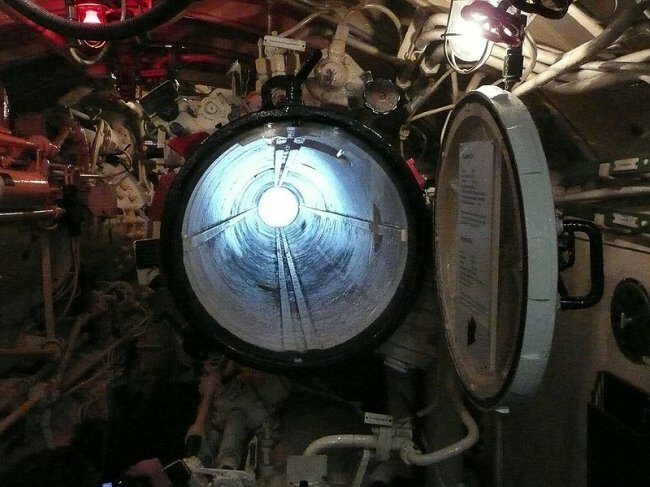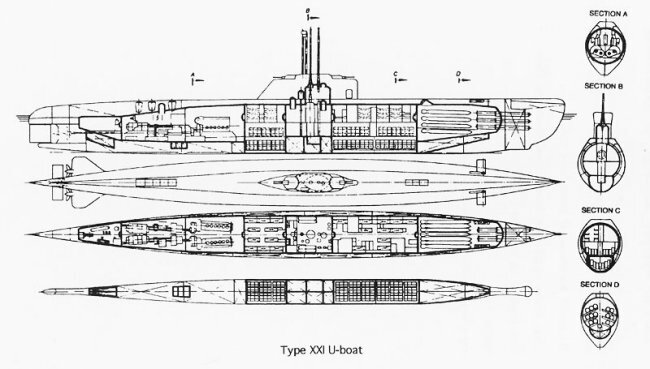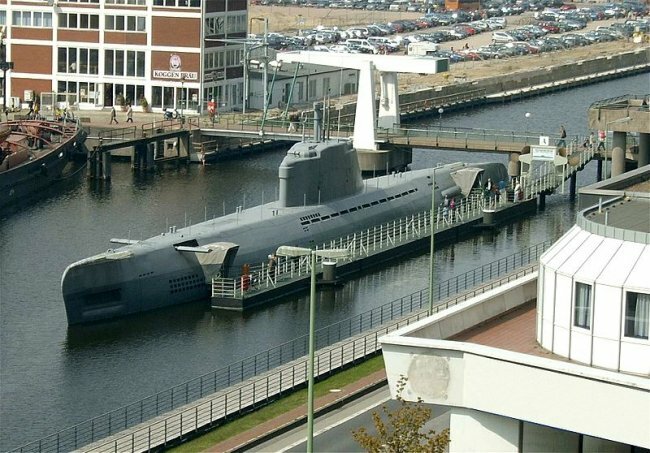Corsairs of the Third Reich
Only by 1944 did the Allies manage to reduce the losses inflicted by them the fleet German submariners
Germanic submarines of World War II were a real nightmare for British and American sailors. They turned the Atlantic into a real hell, where among the wreckage and flaming fuel they desperately cried for the rescue of the victim of torpedo attacks ...
Target is Britain
By the fall of 1939, Germany had a very modest in size, albeit a technically sophisticated navy. Against the British and French battleships and cruisers, 22 could only put up two full-fledged battleships Scharnhorst and Gneisenau and three so-called pocket ships - Deutschland (Deutschland), "Graf Spee" ("Graf Spee") and "Admiral Scheer" ("Admiral Scheer"). The latter carried only six 280 mm guns - despite the fact that at that time the new battleships were armed with 8 – 12 guns with 305 – 406 mm guns. Two more German battleships, the future legends of World War II “Bismarck” (“Bismarck”) and “Tirpitz” (“Tirpitz”) - the full displacement of 50 300 tons, the speed of 30 nodes, eight 380-mm guns - were completed and put into operation after defeat of the allied army at Dunkirk. Of course, this was not enough for a direct battle at sea with the mighty British fleet. This was confirmed two years later during the famous hunt for the Bismarck, when the German battleship with powerful weapons and a well-trained team was simply hunted down by a numerically superior enemy. Therefore, Germany initially relied on the naval blockade of the British Isles and assigned to its battleships the role of raiders - hunters of transport caravans and separate enemy warships.
England was directly dependent on the supply of food and raw materials from the New World, especially the United States, which was its main "supplier" in both world wars. In addition, the blockade would allow to cut off Britain from the reinforcements that were mobilized in the colonies, as well as to prevent the landing of British troops on the continent. However, the success of surface raiders in Germany was short-lived. Their enemy was not only the superior fleet of the United Kingdom, but also the British aviationagainst which the mighty ships were almost powerless. Regular airstrikes on French bases forced Germany in 1941–42 to evacuate their battleships to the northern ports, where they almost ingloriously died during the raids or stood in the repair until the end of the war.
The main force that the Third Reich relied on in the battle at sea was submarines, less vulnerable to aviation and capable of sneaking up even to a very strong enemy. And most importantly, the construction of the submarine was several times cheaper, the submarine required less fuel, it was serviced by a small crew - despite the fact that it could be no less efficient than the most powerful raider.
"Wolf Packs" by Admiral Dönitz
Germany entered World War II with only 57 submarines, of which only 26 were suitable for operations in the Atlantic. However, in September 1939, the German submarine fleet (U-Bootwaffe) sank the 41 ship with a total tonnage of 153 879 tons. Among them - the British liner "Athenia" (which became the first victim of the German submarines in this war) and the aircraft carrier "Koreydzhes." Another British aircraft carrier, Ark-Royal, survived only due to the fact that the torpedoes with magnetic fuses detonated ahead of time with a U-39 submarine. And on the night of 13 on 14 in October, the X-NUMX of the U-1939 submarine commanded by Lieutenant Commander Günther Prien penetrated the British military base Scapa Flow (Orkney Islands) and launched the Royal Oak battleship .

This forced Britain to urgently remove its aircraft carriers from the Atlantic and restrict the movement of battleships and other large warships that were now carefully guarded by destroyers and other escort ships. Successes had an impact on Hitler: he changed his initially negative opinion of submarines, and by his order their mass construction unfolded. Over the next 5 years, 1108 submarines entered the German fleet.
True, given the losses and the need for repairing submarines damaged in the march, Germany at one time could push a limited number of submarines ready for the march — only by the middle of the war did their number exceed a hundred.
The main lobbyist of submarines as a type of armament in the Third Reich was the commander of the submarine fleet (Befehlshaber der Unterseeboote) Admiral Karl Dönitz (Karl D? Nitz, 1891 – 1981), who served on submarines already in the First World War. The world of Versailles forbade Germany to have a submarine fleet, and Dönitz had to retrain as a commander of a torpedo boat, then as an expert in developing new weapons, navigator, commander of a destroyer fleet of destroyers, captain of a light cruiser ...
In the 1935 year, when Germany decided to recreate the submarine fleet, Dönitz was simultaneously appointed commander of the 1 submarine flotilla and received the strange title of “Fuhrer of submarines”. It was a very successful assignment: the submarine fleet was essentially his brainchild, he created it from scratch and turned it into a powerful fist of the Third Reich. Dönitz personally met every boat returning to the base, attended releases of the school of submariners, created special sanatoriums for them. For all this, he was greatly respected by his subordinates, who called him “Papa Karl” (Vater Karl).
In the 1935-38, the Underwater Führer developed a new tactic for hunting enemy ships. Up to this point, submarines of all countries of the world acted alone. Dönitz, serving as commander of the destroyer flotilla, which attacks the enemy with a group, decided to use group tactics in submarine warfare. At first, he proposes a “curtain” method. A group of boats was walking in the sea in a chain. The boat that detected the enemy sent a report and attacked him, while the rest of the boats hurried to her aid.
The next idea was the tactic of the “circle”, in which the boats were located around a certain part of the ocean. As soon as an enemy convoy or warship entered it, the boat, noticing the enemy entering the circle, began to lead the target, maintaining contact with the others, and they began to approach the doomed targets on all sides.

But the wolf pack method, directly developed to attack large transport caravans, became the most famous. The name fully corresponded to its essence - this is how wolves hunt for their prey. After the discovery of the convoy, a group of submarines was parallel to its course. After the first attack, she then overtook the convoy and turned around for a new strike.
The best of the best
During World War II (up to May 1945), German submariners sunk 2603 warships and Allied transport ships with a total displacement of 13,5 million tons. These include the 2 battleship, 6 aircraft carriers, 5 cruisers, 52 destroyers, and more 70 warships of other classes. At the same time about 100 killed thousands of sailors of the military and merchant fleet.
To counteract, the Allies concentrated over 3 000 combat and auxiliary ships, around 1400 aircraft, and by the time of the landing in Normandy they had dealt a crushing blow to the German submarine fleet, from which it could no longer recover. Despite the fact that German industry increased the production of submarines, fewer crews returned from the campaign with good luck. And someone did not return at all. If in the 1940 year, twenty-three were lost, and in the 1941 year - thirty-six submarines, in the 1943 and 1944 losses increased, respectively, to two hundred and fifty and two hundred and sixty-three submarines. In total, during the war, the losses of the German submariners amounted to 789 submarines and 32 000 sailors. But it still was three times less than the number of enemy ships sunk by them, which proved the high efficiency of the submarine fleet.
As in any war, this also had its aces. Gunter Prin became the first underwater corsair to be famous throughout Germany. On his account, thirty ships with a total tonnage 164 953 tons, including the above-mentioned battleship). For this, he became the first officer in Germany to receive oak leaves to the Knight's Cross. The Reich Propaganda Ministry quickly created his cult - and Prien began to receive whole bags of letters from enthusiastic fans. Perhaps he would have been able to become the most successful German submariner, but 8 March 1941, his boat died during the attack of the convoy.
After that, the list of German deep-sea ases was headed by Otto Krechmer (Otto Kretschmer), who sank forty-four ships with a total displacement of 266 629 tons. He was followed by Wolfgang Lüth - 43 ship total displacement 225 X-NUMX tons, Erich Topp (Erich Topp) - 712 ship total displacement 34 193 tons and unheard-of Heinrich Lehmann-Willenbrock (Heinrich Lehmann -th-a-a-a-a-T-a-a-T-TX and the notorious Heinrich Lehmann-Willenbrock (Heinrich Lehmann-a-a-a-a-T-a-a-T-chn) 684 tonnage 25 tonnes, which, together with its U-183, became the character of the feature film “U-Boot” (“Submarine”). By the way, he did not die during the airstrike. After the war, Lehmann-Willenbroke served as captain of the merchant fleet and distinguished himself in the rescue of the commanding Brazilian bulk carrier “Commandante Lear” in the 253 year, and also became the commander of the first German ship with a nuclear reactor. His boat, after the ill-fated drowning right on the base, was raised, went on hikes (but with a different crew) and after the war was turned into a technical museum.
Thus, the German submarine fleet proved to be the most successful, although it did not have such impressive support of surface forces and naval aviation as the British. On the account of the submariners of Her Majesty only 70 combat and 368 German merchant ships total tonnage 826 300 tons. Their allies Americans sank the Pacific theater of war 1178 ships total tonnage 4,9 million tons. Fortune was not favorable to two hundred and sixty-seven Soviet submarines, which during the war torpedoed only 157 warships and enemy transports with a total displacement of 462 300 tons.
"Flying Dutch"
Romantic aura of heroes on the one hand - and the grim reputation of drunks and inhuman murderers on the other. These were the German submariners on the coast. However, they only got drunk once every two or three months when they returned from a hike. It was then that they were in front of the "public", making hasty conclusions, after which they went off to sleep in the barracks or sanatoriums, and then in a completely sober form prepared for a new campaign. But these rare libations were not so much a celebration of victories as a way to relieve the tremendous stress that submariners received on each trip. And even in spite of the fact that the candidates for the crews took part in the psychological selection, there were cases of nervous breakdowns on the submarines of individual sailors, who had to be reassured by the whole team, or simply tied to their bunk.
The first thing that the submariners just got out to sea faced was a terrible cramping. Especially the crews of the VII series submarines, which, being already cramped in design, suffered, in addition, were packed to the eyeballs with everything necessary for long hikes. The berths of the crew and all the free corners were used to store boxes with provisions, so the crew had to rest and eat food wherever it was necessary. To take additional tons of fuel, it was pumped into tanks designed for fresh water (drinking and hygienic), thus drastically reducing its diet.
For the same reason, the German submariners never saved their victims, desperately waving in the middle of the ocean. After all, there was simply nowhere to place them - except to shove them into the released torpedo tube. Hence the reputation of inhuman monsters behind the submariners.
The feeling of mercy was dulled and constant fear for their own lives. During the campaign, I had to constantly fear minefields or enemy aircraft. But the worst were the enemy destroyers and anti-submarine ships, or rather, their depth charges, the close gap of which could destroy the hull of the boat. In this case, one could only hope for a quick death. It was much worse to get heavy damage and to fall forever into the abyss, listening with horror as the compressible hull of the boat cracked, ready to break inward with water streams under pressure of several tens of atmospheres. Or worse, to lie aground forever and slowly suffocate, knowing that there will be no help ...
The film tells about the merciless and brutal submarine warfare in the Atlantic and the Pacific. The use by the opponents of the latest achievements of science and technology, the rapid progress in radio electronics (the use of sonars and anti-submarine locators) made the struggle for supremacy under water uncompromising and exciting.
Hitler's War Machine - Submarines
A documentary from the Hitler War Machine series tells about submarines - silent weapons The Third Reich in the Battle of the Atlantic. Developed and built in secret, they were closer to victory than any other German weapon. During the Second World War (until May 1945), German submariners sank 2603 warships and transport ships of the Allies. At the same time, about 100 thousand sailors of the military and merchant fleet died. German submarines were a real nightmare for English and American sailors. They turned the Atlantic into hell, where amid the wreckage and burning fuel, they desperately cried out for the salvation of the victim of torpedo attacks. This time will rightly be called the heyday of the tactics of “wolf packs”, which was directly developed for attacks on large transport caravans. The name is fully consistent with its essence, that is how wolves hunt their prey. After the convoy was discovered, a group of submarines concentrated parallel to its course. After conducting the first attack, she then overtook the convoy and turned around in position for a new strike.





Information